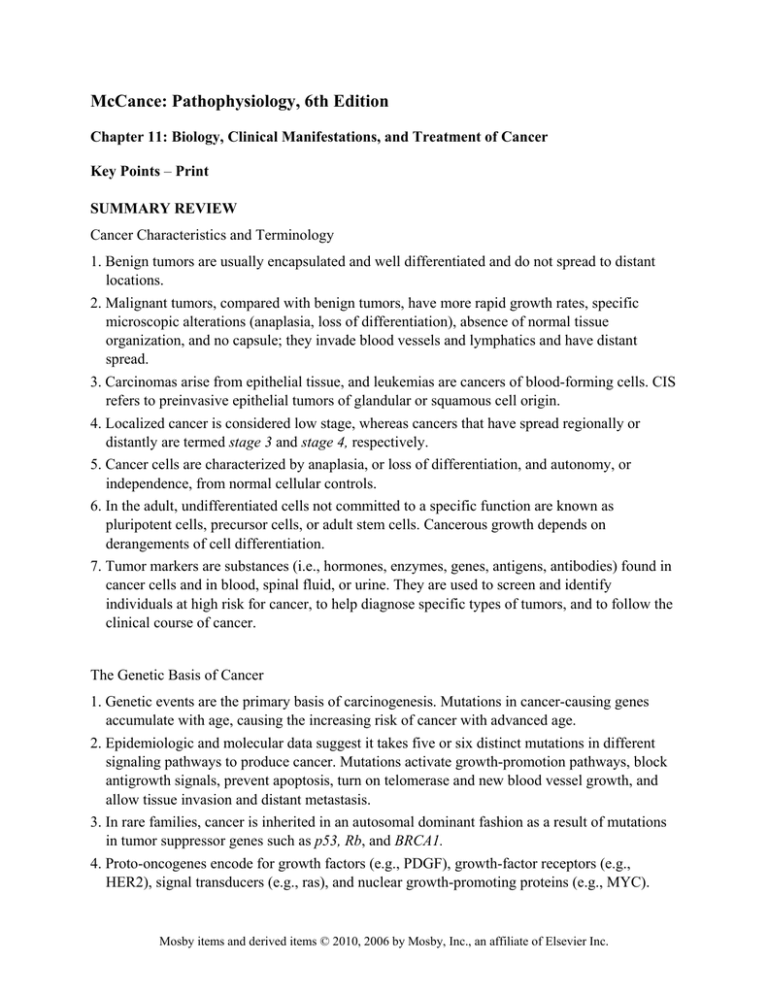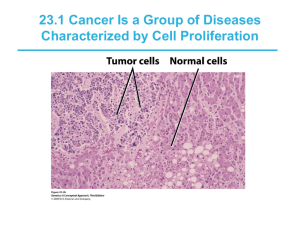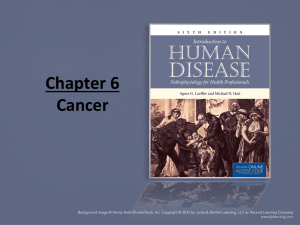Chapter_11
advertisement

McCance: Pathophysiology, 6th Edition Chapter 11: Biology, Clinical Manifestations, and Treatment of Cancer Key Points – Print SUMMARY REVIEW Cancer Characteristics and Terminology 1. Benign tumors are usually encapsulated and well differentiated and do not spread to distant locations. 2. Malignant tumors, compared with benign tumors, have more rapid growth rates, specific microscopic alterations (anaplasia, loss of differentiation), absence of normal tissue organization, and no capsule; they invade blood vessels and lymphatics and have distant spread. 3. Carcinomas arise from epithelial tissue, and leukemias are cancers of blood-forming cells. CIS refers to preinvasive epithelial tumors of glandular or squamous cell origin. 4. Localized cancer is considered low stage, whereas cancers that have spread regionally or distantly are termed stage 3 and stage 4, respectively. 5. Cancer cells are characterized by anaplasia, or loss of differentiation, and autonomy, or independence, from normal cellular controls. 6. In the adult, undifferentiated cells not committed to a specific function are known as pluripotent cells, precursor cells, or adult stem cells. Cancerous growth depends on derangements of cell differentiation. 7. Tumor markers are substances (i.e., hormones, enzymes, genes, antigens, antibodies) found in cancer cells and in blood, spinal fluid, or urine. They are used to screen and identify individuals at high risk for cancer, to help diagnose specific types of tumors, and to follow the clinical course of cancer. The Genetic Basis of Cancer 1. Genetic events are the primary basis of carcinogenesis. Mutations in cancer-causing genes accumulate with age, causing the increasing risk of cancer with advanced age. 2. Epidemiologic and molecular data suggest it takes five or six distinct mutations in different signaling pathways to produce cancer. Mutations activate growth-promotion pathways, block antigrowth signals, prevent apoptosis, turn on telomerase and new blood vessel growth, and allow tissue invasion and distant metastasis. 3. In rare families, cancer is inherited in an autosomal dominant fashion as a result of mutations in tumor suppressor genes such as p53, Rb, and BRCA1. 4. Proto-oncogenes encode for growth factors (e.g., PDGF), growth-factor receptors (e.g., HER2), signal transducers (e.g., ras), and nuclear growth-promoting proteins (e.g., MYC). Mosby items and derived items © 2010, 2006 by Mosby, Inc., an affiliate of Elsevier Inc. Key Points – Print 11-2 5. Three key genetic mechanisms have a role in human carcinogenesis: (1) activation of protooncogenes resulting in hyperactivity of growth-related gene products (such genes are called oncogenes); (2) mutation of genes resulting in loss or inactivity of gene products that normally would inhibit growth (such genes are called tumor-suppressor genes); and (3) mutation of genes resulting in overexpression of products that prevent normal cell death, or apoptosis, thus allowing continued growth of tumors. 6. Tumor-suppressor genes encode for proteins that act as inhibitors of growth-factor stimulation. Tumor-suppressor gene proteins block specific phases of the cell cycle, induce end-stage (e.g., terminal) differentiation, and stimulate cell senescence or death. 7. Carcinogenesis, or the development of cancer, involves both inactivation of tumor-suppressor genes (usually by loss of heterozygosity, or by “silencing”) and activation of oncogenes. 8. Epigenetic changes in genes by DNA methylation and covalent histone modification can mimic mutation by heritably turning tumor-suppressor genes off. 9. Like many normal adult tissues, cancers can contain rare stem cells. To fully eradicate a cancer, it may be necessary to target the cancer stem cell. 10. Caretaker genes are responsible for maintaining genomic integrity. Inherited mutations can disrupt caretaker genes and cause chromosome instability. 11. A number of viruses can cause cancer. Human cervical cancer is caused by papillomavirus infection. Kaposi sarcoma is caused by infection with a member of the herpesvirus family. Chronic hepatitis infection is the leading cause of liver cancer. 12. Defects in the immune system increase the risk of viral-associated cancers but have a minimal effect on the risk of other cancers. 13. Active inflammation predisposes to cancer by stimulating a wound-healing response that includes proliferation and new blood vessel growth. 14. Vaccinations can prevent hepatitis B–associated liver cancer and many human papillomavirus-caused cervical cancers 15. Chronic H. pylori causes stomach cancer and a rare lymphoma. 16. Metastasis is the major cause of death from cancer. 17. Cancers metastasize by several routes, including direct invasion and spread through lymphatics and veins. 18. Metastasis is a complex process that requires cells to have many new abilities, including the ability to invade, survive, and proliferate in a new environment and recruit new blood vessel growth. Clinical Manifestations of Cancer 1. The diagnosis of cancer requires a biopsy and examination of tumor tissue by a pathologist. Cancer classification is established by a variety of tests. Mosby items and derived items © 2010, 2006 by Mosby, Inc., an affiliate of Elsevier Inc. Key Points – Print 11-3 2. Tumor staging involves the size of the tumor, the degree to which it has locally invaded, and the extent to which it has spread. A standard scheme for staging is the T (tumor spread), N (node involvement), and M (metastasis) system. 3. Paraneoplastic syndromes are rare symptom complexes often caused by release of active substances from or stimulation of an immune response by a cancer that causes symptoms not directly caused by the local effects of the cancer. Cancer Treatment 1. Cancer is treated with surgery, radiation therapy, chemotherapy, and combinations of these modalities. 2. The theoretic basis of chemotherapy is the vulnerability of tumor cells in various stages of the cell cycle. The goal of chemotherapy is to eradicate enough tumor cells so the body’s natural defenses can eradicate remaining cells. 3. Modern chemotherapy uses combinations of drugs with different targets and different toxicities. 4. A new generation of specific targeted drugs attacks targets identified by the molecular analysis of cancers. 5. Ionizing radiation causes cell damage, so the goal of radiation therapy is to damage the tumor without causing excessive toxicity or damage to undiseased structures. 6. Surgical therapy is used for nonmetastatic disease, for which cure is possible by removing the tumor, and as a palliative measure to alleviate symptoms. 7. Clinical manifestations of cancer include pain, cachexia, anemia, leukopenia, thrombocytopenia, and infection. 8. Pain is generally associated with the late stages of cancer. It can be caused by pressure, obstruction, invasion of a structure sensitive to pain, stretching, tissue destruction, and inflammation. 9. Fatigue is the most frequently reported symptom of cancer and cancer treatment. 10. Cachexia (loss of appetite, early satiety, weakness, inability to maintain weight, taste alterations, altered metabolism) leads to protein-calorie malnutrition and progressive wasting. 11. Anemia associated with cancer usually occurs because of malnutrition, chronic bleeding and resultant iron deficiency, chemotherapy, radiation, and malignancies in the blood-forming organs. 12. Leukopenia is usually a result of chemotherapy (which is toxic to bone marrow) or radiation (which kills circulating leukocytes). 13. Thrombocytopenia is usually the result of chemotherapy or malignancy in the bone marrow. 14. Infection may be caused by leukopenia, immunosuppression, or debility associated with advanced disease. It is the most significant cause of complications and death. Mosby items and derived items © 2010, 2006 by Mosby, Inc., an affiliate of Elsevier Inc.


